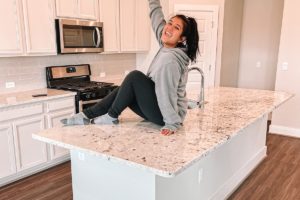
As Jacob and I have been settling into our new home, we have been spending our weekends knocking out a ton of DIY projects! One of the first things we knew we wanted to do was install board and batten around the house to add some personality to the plain walls. So far, we’ve done 3 walls and they’ve all turned out so well!
Since I’ve been sharing on my Instagram stories, so many of you have had questions on a step-by-step tutorial, materials we used, and pricing, so I figured it would be helpful to put it all in a blog post for y’all so that you can refer to it whenever you’re ready to do this in your own home!
So let’s get to it!

MATERIALS
- .75 in x 1.5in Poplar Boards (the amount depends on how many boards you want on your wall)
- Miter Saw
- Brad Nailer
- Nail Setter Kit
- Level
- Liquid Nails
- Caulking
- Dry Wall Spackling
- Sand Paper
- Painter’s Tape
- Paint of choice
- Optional (or depending on your baseboards): you may need to replace your baseboards depending on the style of yours. Ours are bigger, thicker, and have a straight edge, so luckily we didn’t need to replace ours. If yours are rounded or really small, you’ll definitely want to replace them with something equivalent to the thickness of the poplar boards or else this won’t look as good and the boards will pop out. THIS is the style we have in our home.
STEPS
REPLACE YOUR BASEBOARD: this step isn’t going to be necessary for everyone (as mentioned in the bullet point above), but if your baseboards are small or rounded, then I would highly recommend doing this if you want your wall to look professionally done. Replacing the baseboards may seem like a big job, but it’s actually fairly easy and you can find lots of tutorials on YouTube.
MEASURE: First, you will want to decide how many boards you want to go across your wall. The way we decided this was by figuring out about how much spacing we wanted in between the boards and then picked an amount based on the size of our wall. Also keep in mind the plug on your wall. You’ll want to work around that when considering the number of boards, if possible, so that you don’t have to worry about cutting a chunk out of the board. Once we decided how many boards we wanted on the wall, we used an equation to figure out exactly how many inches would be in between each board. This equation below will make sure that the boards are the EXACT same distance apart and are evenly spread out on your wall.
- # of boards x width of board = X
- length of wall – X = Y
- Y / # of spaces between the boards = inches between each board
After you have done this equation, you can then start marking your wall with a pencil where the boards will go! This made it MUCH easier when installing the boards.
CUT: Now it’s time to cut the boards to fit your wall. This is where it can get tricky. More than likely, your ceiling height along the top of your wall isn’t going to be exact all the way across, so you will likely have to cut a few boards either a tad longer or shorter than the rest, depending on your wall. First, start by measuring the wall from the baseboard up to the ceiling using a tape measure. Cut the first board using a miter saw. Then take that board and use it as a guide to see if it fits where each board will go along the wall. If it does, then great! Cut the rest of the boards the exact same length.
If not, then this is where you’ll need to adjust and cut a little bit more or less off of the next board you cut. This is why I think it’s super important to have a miter saw when doing DIY projects like this rather than having Home Depot cut the boards for you. Sometimes not every board is going to be the exact same length and you’ll need to have a miter saw handy in case you need to trim a bit more off. You can also use a hand saw for this, but that does require more work and it’s not as precise.
INSTALL THE BOARDS: Now that all of your boards have been cut to fit your wall, you will apply liquid nails to the back of your boards as you go, apply it to the wall where you previously marked, and use a level to make sure the board is straight and even. Then you will use a brad nailer to secure the boards to the wall. Repeat this process until all of your boards are installed! If you have any nails sticking out that didn’t go all the way into the boards, this is when you would use the nail setter to hammer the nails into the wood so that they aren’t sticking out.

PATCH NAIL HOLES: Next, you will use dry wall spackling to cover all of the nail holes that were created using the brad nailer. If you don’t patch these holes, then they will show when you paint, so do not skip this step! I just use my finger to apply the dry wall spackling in each nail hole and smooth it out by also using my finger. The spackling doesn’t need to be perfect, as you are going to sand it down after it dries.
SAND: Once the dry wall spackling is dry (it only takes about an hour), you can then sand down the boards using 220 grit sand paper, focusing on the areas that you patched. This will make them super smooth and flat, and will also remove any stray wood on the edges and corners. Once it’s all sanded, you’ll want to clean up the area using a ShopVac and wipe down the boards/wall with a damp cloth to make sure it’s free of all the dust that was created while sanding.
CAULK: On to the messy part lol. Although caulking can be tedius and messy, it is a step you should NOT skip. Caulking the seams where the boards meet the wall will cover the gaps and make the wall look seamless and professionally done. Always caulk using a wet finger. We usually just have a small bowl with water and dish soap in it and dip our finger in it before smoothing. The dish soap really helps! Also, I would HIGHLY recommend using painter’s tape first and applying it next to the seam leaving a tiny gap between the wood and wall. Then go in and apply the caulking. This will help eliminate the smearing and messiness on the wall that happens when smoothing the caulking. After you smooth an area, remove the painter’s tape right afterwards. You don’t want the caulking to dry before removing the tape. After everything is caulked, you can wait about 2 hours before it’s ready to be painted.

PAINT: Now for the fun part! At least for me lol. Painting does take time and patience, but I just put on a show in the background and enjoy the process. You will definitely want to use painters tape to tape your edges before you get started. And then paint away!

PRICING
Since we already had the miter saw and the brad nailer, the biggest expense was the wood. We did 15 boards on this wall and it cost us around $150. All of the other small things that you need are very inexpensive, so all together it only cost us around $200 to do this entire wall. We also had the paint already, so we didn’t have that expense either. If you had nothing on the materials list and you needed to buy everything, it would cost you around $600 total. If you were to hire someone to do this, it would likely cost you into the thousands.
If you are someone who is planning to do more DIY projects, I would highly recommend investing in a miter saw and a brad nailer! They have helped TREMENDOUSLY with our projects and they have allowed us to do everything in our home on our own, which has saved us SO much money and added a ton of character to our home at the same time.
I really hope this post helped and maybe inspired you to try this yourself in your own home! It’s such a fun weekend project and makes the biggest difference! If you end up trying this, I would love to see your pics, so feel free to send me a DM on Instagram! Or even if you have any questions, send me a message and I can try and help as best as I can! I’m not a pro lol but I’ve definitely learned a lot! Thank you so much for reading and I hope it helped!
XOXO Kristle






